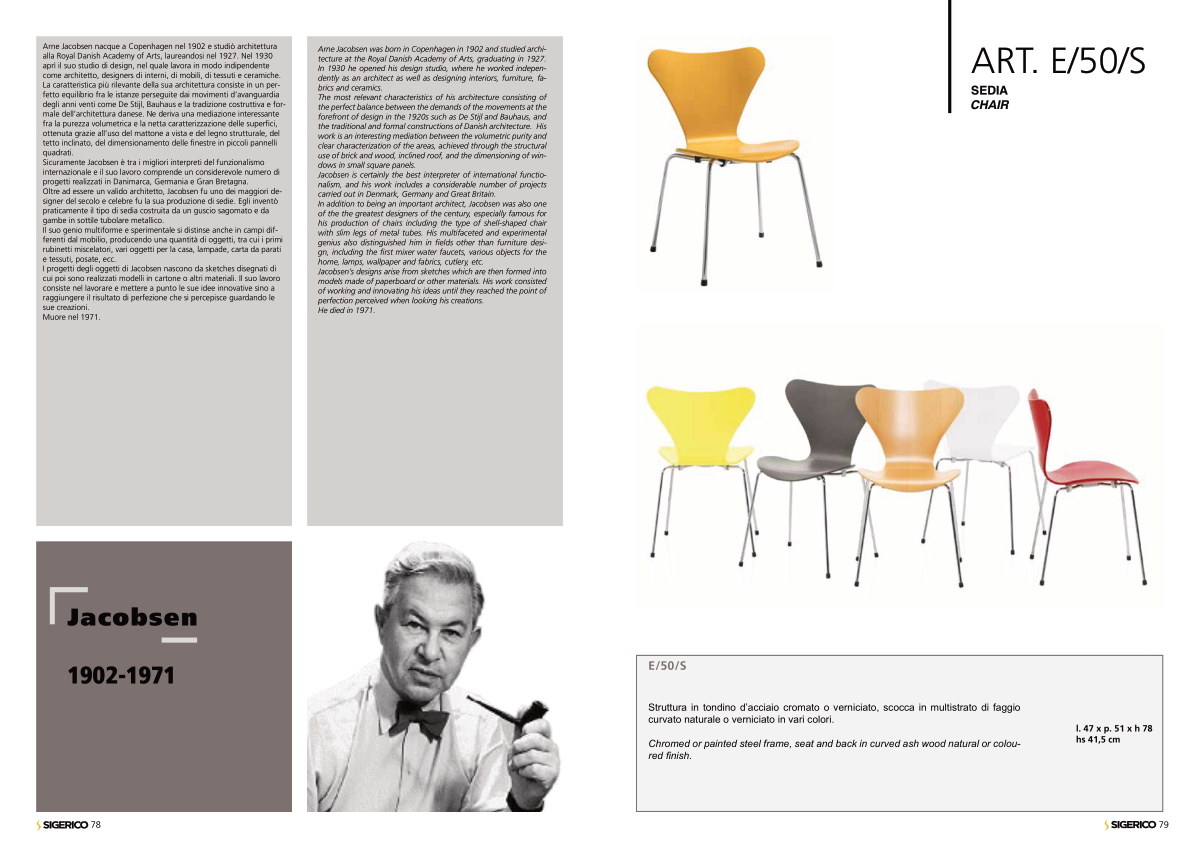Jacobsen
1902-1971
Arne Jacobsen nacque a Copenhagen nel 1902 e studiò architettura
alla Royal Danish Academy of Arts, laureandosi nel 1927. Nel 1930
aprì il suo studio di design, nel quale lavora in modo indipendente
come architetto, designers di interni, di mobili, di tessuti e ceramiche.
La caratteristica più rilevante della sua architettura consiste in un per-
fetto equilibrio fra le istanze perseguite dai movimenti d’avanguardia
degli anni venti come De Stijl, Bauhaus e la tradizione costruttiva e for-
male dell’architettura danese. Ne deriva una mediazione interessante
fra la purezza volumetrica e la netta caratterizzazione delle superfici,
ottenuta grazie all’uso del mattone a vista e del legno strutturale, del
tetto inclinato, del dimensionamento delle finestre in piccoli pannelli
quadrati.
Sicuramente Jacobsen è tra i migliori interpreti del funzionalismo
internazionale e il suo lavoro comprende un considerevole numero di
progetti realizzati in Danimarca, Germania e Gran Bretagna.
Oltre ad essere un valido architetto, Jacobsen fu uno dei maggiori de-
signer del secolo e celebre fu la sua produzione di sedie. Egli inventò
praticamente il tipo di sedia costruita da un guscio sagomato e da
gambe in sottile tubolare metallico.
Il suo genio multiforme e sperimentale si distinse anche in campi dif-
ferenti dal mobilio, producendo una quantità di oggetti, tra cui i primi
rubinetti miscelatori, vari oggetti per la casa, lampade, carta da parati
e tessuti, posate, ecc.
I progetti degli oggetti di Jacobsen nascono da sketches disegnati di
cui poi sono realizzati modelli in cartone o altri materiali. Il suo lavoro
consiste nel lavorare e mettere a punto le sue idee innovative sino a
raggiungere il risultato di perfezione che si percepisce guardando le
sue creazioni.
Muore nel 1971.
Arne Jacobsen was born in Copenhagen in 1902 and studied archi-
tecture at the Royal Danish Academy of Arts, graduating in 1927.
In 1930 he opened his design studio, where he worked indepen-
dently as an architect as well as designing interiors, furniture, fa-
brics and ceramics.
The most relevant characteristics of his architecture consisting of
the perfect balance between the demands of the movements at the
forefront of design in the 1920s such as De Stijl and Bauhaus, and
the traditional and formal constructions of Danish architecture. His
work is an interesting mediation between the volumetric purity and
clear characterization of the areas, achieved through the structural
use of brick and wood, inclined roof, and the dimensioning of win-
dows in small square panels.
Jacobsen is certainly the best interpreter of international functio-
nalism, and his work includes a considerable number of projects
carried out in Denmark, Germany and Great Britain.
In addition to being an important architect, Jacobsen was also one
of the the greatest designers of the century, especially famous for
his production of chairs including the type of shell-shaped chair
with slim legs of metal tubes. His multifaceted and experimental
genius also distinguished him in fields other than furniture desi-
gn, including the first mixer water faucets, various objects for the
home, lamps, wallpaper and fabrics, cutlery, etc.
Jacobsen’s designs arise from sketches which are then formed into
models made of paperboard or other materials. His work consisted
of working and innovating his ideas until they reached the point of
perfection perceived when looking his creations.
He died in 1971.
ART. E/50/S
SEDIA
CHAIR
Struttura in tondino d’acciaio cromato o verniciato, scocca in multistrato di faggio
curvato naturale o verniciato in vari colori.
Chromed or painted steel frame, seat and back in curved ash wood natural or colou-
red finish.
l. 47 x p. 51 x h 78
hs 41,5 cm
79
78
E/50/S


